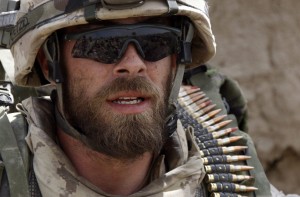
Photo courtesy of The Big Picture
“Art therapy can engage the creative potential of individuals — especially those suffering from PTSD. Art therapy is considered a mind-body intervention that can influence physiological and psychological symptoms. The experience of expressing oneself creatively can reawaken positive emotions and address symptoms of emotional numbing in individuals with PTSD.” – Josée Leclerc, a professor in the Department of Creative Arts Therapies
Highlights of the study:
- 10% of Canadian soldiers exposed to war zones develop chronic PTSD
- Participants were 28-56 years of age
- Participants suffered from various problems including chronic pain, isolation depression, thoughts of suicide, insomnia, anxiety, etc.
- Themes included tolerance vs anger, grief and loss, new beginnings, etc.
- Art therapy helped soldiers evoke positive emotions
- Art therapy helped soliders externalize emotions and learn about symptoms
- Art therapy aided discussion and feelings of empathy with other veterans
- Art Therapy provides an alternative form of expression suited for those suffering from PTSD.
We’ve mentioned various PTSD and art therapy studies before, but a more recent one by Cheryl Miller finds that art therapy is capable of relieving psychological traumas suffered at the hands of war. The study was conducted in the Creative Arts Therapies Department of Concordia University (an art therapy school in Canada).
The participants of the study were veterans from Afghanistan and Iraq, between 28 and 56 years old and suffered from things like depression, isolation, suicidal thoughts, anxiety, chronic pain, insomnia, and other various problems.
Art therapy was offered two times a week to soldiers affected by Post Traumatic Stress Disorder (PTSD). They used a variety of art supplies including paints, clay, markers, charcoal, and images for collages. Afterwards, behavior forms were filled out by the nurses and therapists. The employees of the veterans’ hospital involved in the study indicated that art therapy did appear to have positive impacts and benefits for its participants.
“Through art, participants were able to express positive feelings, externalize difficult emotions and gain insight into their PTSD symptoms. Art-making fostered discussion and allowed veterans to show empathy for one another,” said Cheryl Miller.
Cheryl also stated that group dynamics played a key role in the study: “Through the process of creating and discussing art with peers, participants were able to open up and express important thoughts and emotions in an atmosphere of mutual support.”
It was also noted by Miller that group dynamics were very helpful when dealing with people who 1) have lost interest in doing pleasurable things 2) are feeling detached and 3) have a reduced view of the future.
More information about the study, along with access to the full dissertation can be found here. This appears to have changed locations. Here is the old location: http://gradworks.umi.com/MR/67/MR67258.html
I’m so glad to read of studies like this. More than anything, art has helped me get in touch with emotions that seemed untouchable…and you often have something tangible to show for it. I’m so glad yoga/ptsd and art therapy/ptsd are becoming mainstream – it’s about time!
Too bad the study is not available for public access. Why science articles are not being published directly by their authors?
Studies are available to read. You have to become a member or purchase the article.
Please check out the Grenade series at http://www.laboratoriodigiuseppe.com/current-works.html
There are a series of photographs which illustrate the effects of Post Traumatic Stress Disorder on soldiers and their families.